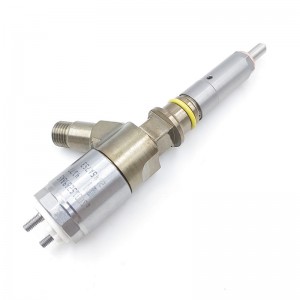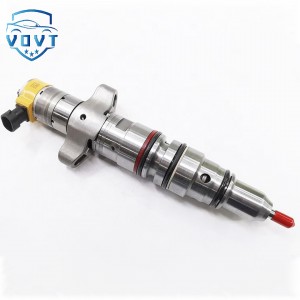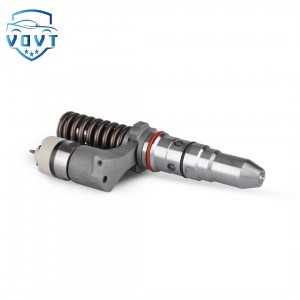New High Quality Diesel Injector 101-8673 107-7733 107-1230 127-8205 127-8207 127-8209 127-8211 For CAT 3116
Products Description
| Reference. Codes | 3116 |
| Application | 3116 |
| MOQ | 4PCS |
| Certification | ISO9001 |
| Place of Origin | China |
| Packaging | Neutral packing |
| Quality Control | 100% tested before shipment |
| Lead time | 7~10 working days |
| Payment | T/T, L/C, Paypal, Western Union, MoneyGram or as your requirement |
How do injector pressure fluctuations affect engine emissions?
Pressure fluctuation leads to combustion phase disorder
1. Injection timing misalignment and mixture ratio fluctuation
Pressure increase stage:
Instantaneous high pressure may increase the injection advance angle (such as from the standard 15°CA BTDC to 20°CA BTDC), the fuel is injected in the early stage of the compression stroke, the temperature in the cylinder is low, forming an "over-rich mixture area", and a large amount of carbon soot (PM) is generated after combustion.
Pressure drop stage:
Instantaneous low pressure causes injection delay (such as delay to 5°CA BTDC), the fuel is injected after the ignition moment, the local oxygen-rich environment triggers intense combustion, the cylinder temperature rises sharply (over 2300K), and the amount of nitrogen oxides (NOx) generated surges.
Data comparison:
When the pressure fluctuates by ±10%, PM emissions can increase by 40%-60% compared with stable conditions, and NOx increases by 30%-50% (Source: SAE paper "Common Rail Pressure Fluctuation Impact on Diesel Emissions").
2. The unevenness of each cylinder's operation is aggravated
In a multi-cylinder engine, pressure fluctuations may cause the difference in fuel injection between cylinders to exceed 15% (normal should be <5%):
Due to excessive instantaneous high-pressure fuel injection in a cylinder, "incomplete combustion → soot + CO" emissions occur;
Due to insufficient instantaneous low-pressure fuel injection in the adjacent cylinder, the air-fuel ratio is too high, causing "high-temperature oxygen-rich → NOx" emissions.
Typical phenomenon:
Intermittent black smoke (at low pressure) and colorless transparent exhaust gas (at peak pressure, NOx surges but no soot) can be seen alternating in the exhaust pipe.
Characteristics of emission pollutants caused by pressure fluctuations
1. Deterioration of particle size distribution of soot (PM)
Stable pressure conditions:
Soot particles are mainly fine particles (<0.1μm), which are easily captured by DPF.
Fluctuating pressure conditions:
More nano-sized particles (0.01-0.1μm) are formed in the high pressure stage, and the number concentration can increase by 2-3 orders of magnitude (such as from 10⁷/cm³ to 10⁹/cm³), and the risk of penetrating the DPF increases significantly;
Coarse particles (>1μm) are generated in the low pressure stage, resulting in faster DPF clogging (such as the clogging cycle is shortened from 5000 km to 2000 km).
2. Synergistic pollution of NOx and HC
High pressure-high temperature period:
The amount of NOx generated can reach 1.5 times that of stable conditions (such as from 800ppm to 1200ppm), and some fuel is cracked by high temperature to generate toxic HC compounds such as formaldehyde (HCHO) (concentration increased by 50%-80%).
Low pressure - low temperature period:
Unburned HC (such as benzene) emissions increase, reacting with NOx in the atmosphere to generate photochemical smog precursors, exacerbating secondary pollution.
Chain damage to post-treatment systems
1. DPF (diesel particulate filter) overload
Frequent regeneration leads to shortened life:
Pressure fluctuations cause soot emissions to increase in a pulsed manner, and the efficiency of DPF passive regeneration (relying on exhaust heat to burn soot) is insufficient, requiring frequent activation of active regeneration (fuel injection to assist combustion).
The active regeneration frequency increases from once every 10 hours to once every 3 hours, causing cracks in the DPF carrier due to high-temperature oxidation (>650℃), and the life span is reduced from 800,000 kilometers to less than 300,000 kilometers.
Accelerated ash accumulation:
Fluctuating combustion may cause oil dilution (fuel seeping into the crankcase), and oil ash (such as calcium and magnesium compounds) enters the DPF with exhaust gas, and the ash capacity is saturated in advance (normal ash capacity is about 15g/L, and abnormal 6-8g/L is blocked).
2. Collapse of SCR system efficiency
Risk of catalyst poisoning:
Pressure fluctuations may cause intermittent "fuel-rich combustion", and unburned HC reacts with SCR catalysts (such as vanadium-based) to produce vanadium sulfate (V₂(SO₄)₃) to cover the active sites, causing the NOx conversion rate to drop sharply from 95% to below 40%.
Intensified ammonia slip:
In order to cope with fluctuating NOx emissions, the ECU may over-inject urea, and unreacted ammonia (NH₃) is discharged with the exhaust gas, forming "secondary pollution" (ammonia emission limit is 0.01ppm, and can reach more than 0.1ppm in abnormal cases).
Failure of the real road emission (RDE) test
Regulatory compliance risk:
In the European RDE or China real road emission test, pressure fluctuations may cause:
PM-RDE value exceeds the limit (0.023g/km) by more than 2 times;
NOx-RDE value exceeds the limit (0.08g/km) by 1.5 times, triggering a vehicle emission recall.
OBD diagnostic system false alarm:
Pressure fluctuations may cause multiple fault codes (such as P0236 - Common rail pressure fluctuation is too large, P242F-DPF is inefficient), causing the on-board diagnostic system to misjudge it as a post-treatment system failure and light up the emission warning light.
Typical fault cases and troubleshooting directions
Case 1: The annual emission inspection smoke density of a certain National VI light truck exceeds the standard
Phenomenon: The free acceleration smoke density value is 1.2m⁻¹ (limit 0.5m⁻¹), and the exhaust black smoke is found to erupt periodically during the test.
Cause: The common rail pressure sensor wiring harness has poor contact, causing the pressure to fluctuate between 120-160MPa (standard value 140±5MPa), causing the cylinders to alternately have excessive and insufficient fuel.
Solution: Replace the sensor and repair the wiring harness, and the smoke value is reduced to 0.3m⁻¹.
Case 2: Frequent DPF blockage of a heavy truck
Phenomenon: Active regeneration is required every 1500 kilometers. After disassembling the DPF, it is found that the local soot accumulation is "layered" (pressure fluctuations cause uneven soot deposition).
Cause: The injector needle valve pair is worn, causing the single-cylinder injection pressure to fluctuate between 18-25MPa (standard 22MPa).
Solution: Replace the 6-cylinder injector, and the DPF regeneration cycle is restored to 5000 kilometers.
Preventive and repair measures
Precise control of pressure source:
Install a high-precision common rail pressure sensor (accuracy ±0.5% FS) and calibrate it regularly (it is recommended to use an oscilloscope to detect the pressure waveform every 20,000 kilometers, and the fluctuation amplitude should be <±2MPa).
Injector consistency maintenance:
Use the injector test bench to match the opening pressure of each cylinder injector (the difference should be <1MPa), and replace the worn needle valve pair (must be replaced when the wear amount is >0.003mm).
Preventive maintenance of the post-treatment system:
Use special equipment to clean the DPF (such as ultrasonic cleaning) every 50,000 kilometers, and detect the activity of the SCR catalyst (use the NOx sensor to measure the conversion rate, and regenerate or replace it when it is lower than 85%).























